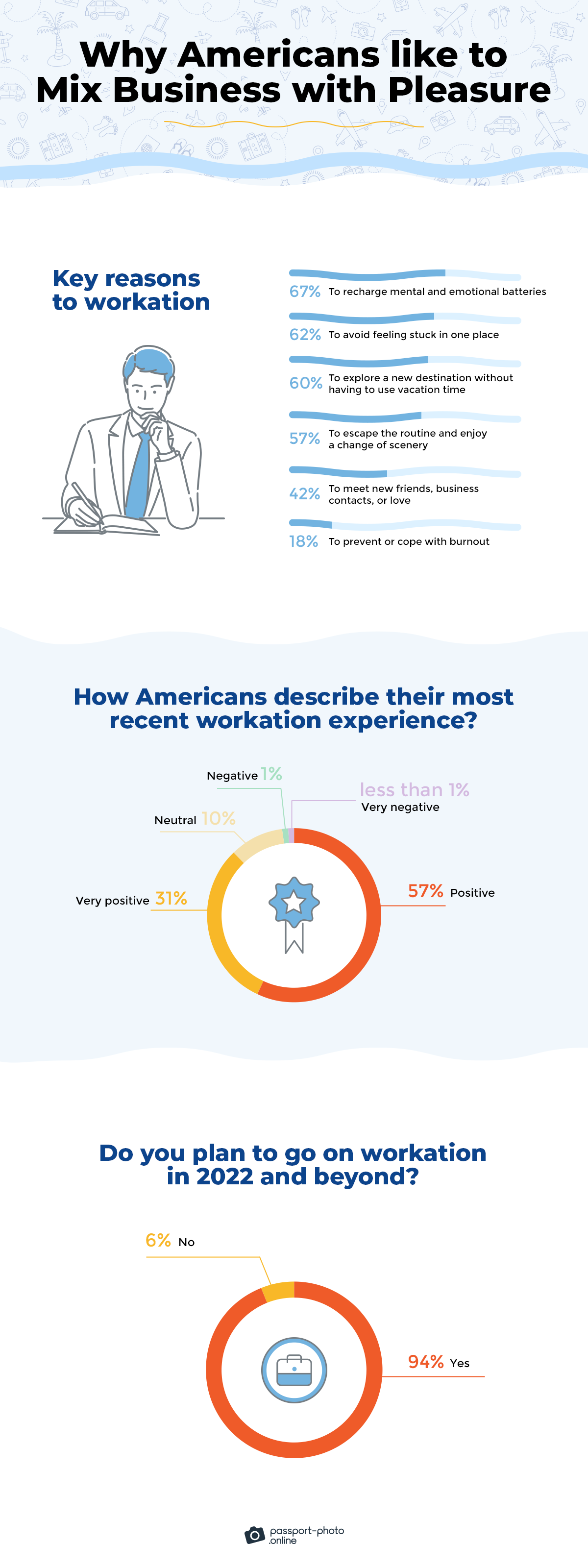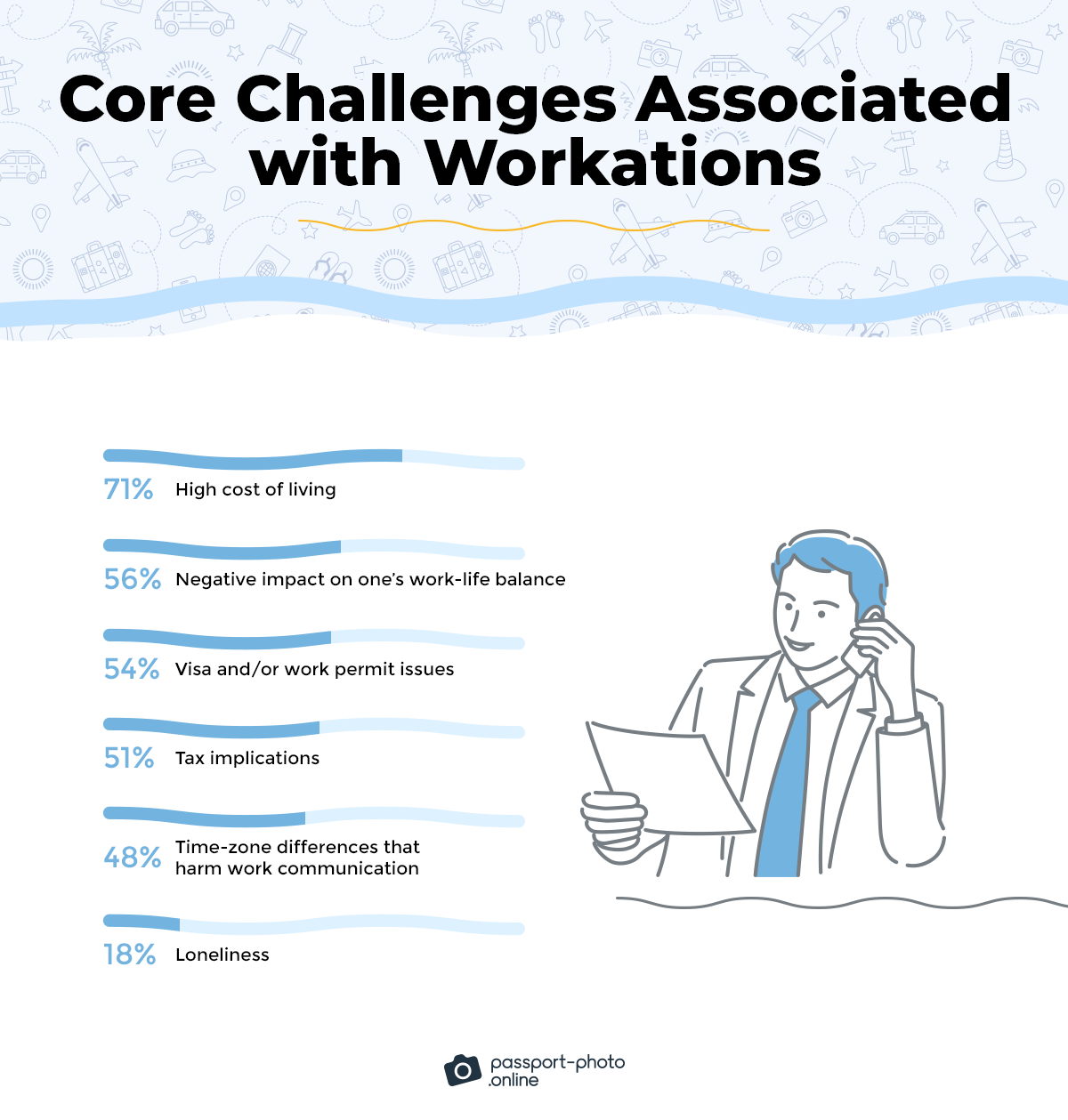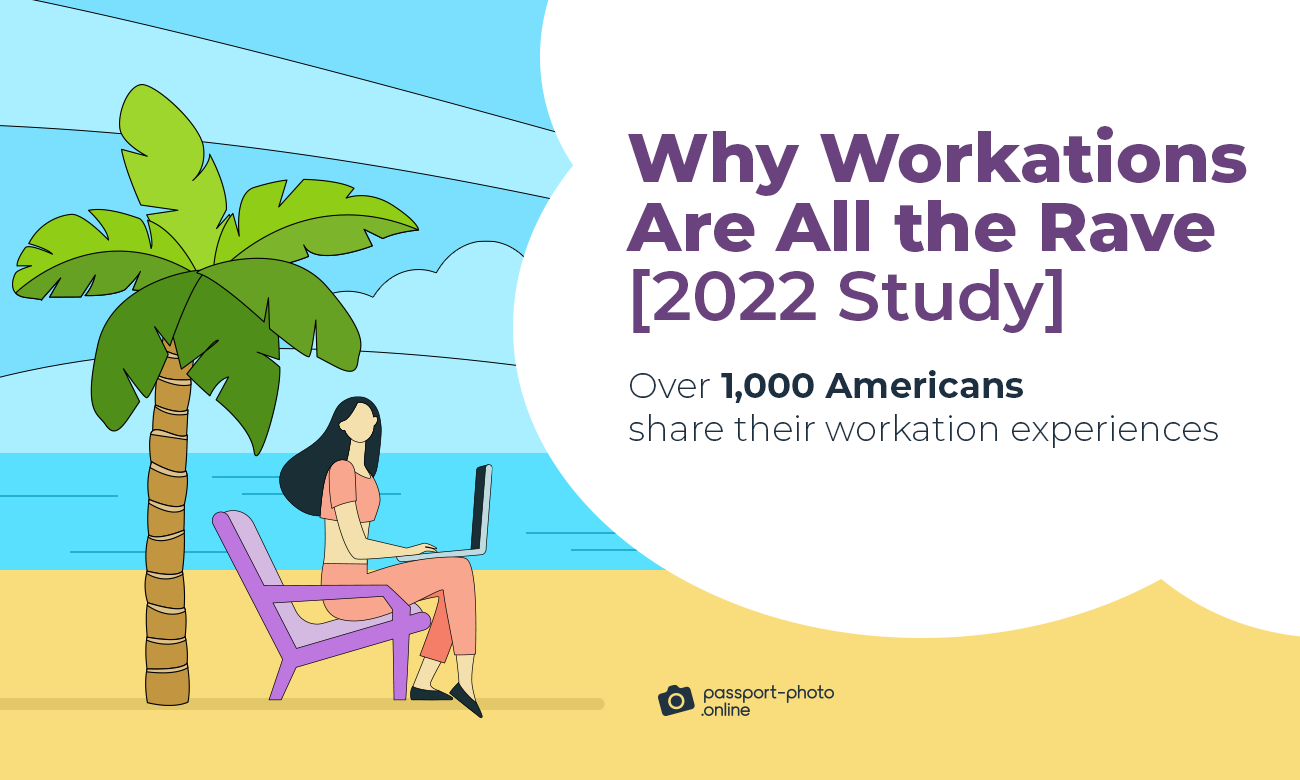10 days.
That’s how much PTO Americans get on average.
Compare that to Europe, where most countries give workers at least 20 workdays off with many EU members going well above that number (e.g., in France, you get 30), and you’ll see why some call us a no-vacation nation.
So—
A growing number of people are now looking to blend work and play, i.e., go on vacation while continuing to work remotely. After all, telecommuting and hybrid setups continue to reign supreme in 2022.
For that reason, at Passport Photo Online, we’ve decided to poll 1,000+ Americans on their recent workation experiences, discover what challenges they faced, how it affected their workplace performance, and much more.
Key Takeaways
- Most Americans (67%) went on workation to “recharge their mental and emotional batteries.” Another 94% plan to workation again in 2022 and beyond.
- A full 86% of employees agree or strongly agree a workation boosted their productivity.
- 81% of Americans grew more creative at work after taking a workation.
- Nearly 69% are less likely to quit after going on workation.
- As many as 83% agree/strongly agree a workation helped them cope with burnout.
- Roughly 84% are now more satisfied with their job.
The Where, The Why, and The How Long

For starters, we wanted to see how Americans workationed in late 2020 and throughout 2021.
It turns out, most (82%) opted for a domestic trip (vs. 18% who traveled internationally). Of those, 53% went to a different city within their home state, and 47% of the respondents decided to go to another city within the US.
That makes sense.
With health concerns, ever-changing travel restrictions, and COVID-19 variants like Omicron keeping the industry in limbo, it was everything but easy to make international travel plans. Yet, not impossible, as the 18% of the international workation travelers prove. Here are their top five destination picks:
- UK: 39%
- Mexico: 14%
- Canada: 8%
- Columbia: 6%
- Germany: 5%
Now—
Here’s how long American employees explored a work-life blend on the road:
- 1–2 weeks: 36%
- 3–4 weeks: 32%
- Over a month: 13%
- Less than a week: 10%
- Two months or more: 9%
As you can see, medium- and long-term workations are the most popular choices. Perhaps, that’s because they offer a nearly unprecedented luxury to sample a city or country for more than just a few days.
Next, we asked where Americans stayed during their most recent workation. Below are the responses:
- Friends or family: 43%
- Hotel: 31%
- Airbnb: 18%
- Couchsurfing: 4%
- RV: 2%
- Hostel: 2%
Lastly, here’s what US workers paid attention to when choosing accommodation for a workation:
- Reliable internet: 65%
- Health and safety standards: 63%
- Online ratings and reviews: 63%
- Suitable space to work: 63%
- Price: 52%
- Flexibility to cancel without penalty: 50%
- Proximity to attractions: 28%
- Presence of a quiet room for meetings: 15%
To sum up, most working professionals opted for domestic workations in 2020–2021, likely due to health concerns and uncertainty surrounding the travel industry today. Duration-wise, over half chose to work and travel for 1–4 weeks while staying with friends and family or at hotels. In either instance, “reliable internet” was key.

Do you need passport photos? Find out more:
Why Americans like to Mix Business with Pleasure

At this stage, we wanted to explore American employees’ core motivations to workation beyond the obvious ones like hitting the beach while hitting one’s targets.
Below are the results:
- To recharge mental and emotional batteries: 67%
- To avoid feeling stuck in one place: 62%
- To explore a new destination without having to use vacation time: 60%
- To escape the routine and enjoy a change of scenery: 57%
- To meet new friends, business contacts, or love: 42%
- To prevent or cope with burnout: 18%
As you can see, most Americans opted for a workation to recharge their batteries. That’s not all that surprising, as nearly half of us feel mentally and physically exhausted at the end of the workday, according to a new SHRM study.
Interestingly, 18% of the survey participants took a workation specifically to prevent or cope with burnout (a state of physical or emotional exhaustion that comes from chronic stress). In fact, burnout has become such a pressing issue in recent years that WHO officially recognized it as an occupational health issue.
Moving along, we asked employees to describe their most recent workation experience to see how satisfied they are with this type of holiday:
- Positive: 57%
- Very positive: 31%
- Neutral: 10%
- Negative: 1%
- Very negative: <1%
As a follow-up, we asked if they plan to go on workation in 2022 and beyond. For 94% of the respondents, it was a resounding “Yes.”
Biggest Workation Expenses

Let’s be honest:
Our financial responsibility often goes out the window when we go on trips. A recent LearnVest study found that 74% of Americans fall into debt of over $1,100 after returning from a holiday.
The reasons?
While there’s a host of them, the most common is “malleable mental accounting”, according to Klaus Wertenbroch, a marketing professor at INSEAD. In essence, it’s justifying your spending based on the current circumstances rather than sticking to a strict budget.
Wertenbroch gives an example: if you budget $100 per day, you might get tempted to spend another $30 on food by categorizing it as an everyday purchase rather than strictly holiday spending. As a result, you’ll justify spending $130 vs. the original $100.
Hee adds that conservative budgets don’t always work either. If you set aside $1,000 for a week trip and realize you still have $500 left on the last day, it makes it much easier to splurge before you go home.
Now—
With that in mind, here are Americans’ biggest workation expenses:
- Food and drinks: 82%
- Transportation: 72%
- Housing: 66%
- Entertainment: 64%
- Sightseeing: 24%
Core Challenges Associated with Workations

Is it all sunshine and roses after all?
Maybe not. Here’s a list of challenges our respondents faced on workation:
- High cost of living: 71%
- Negative impact on one’s work-life balance: 56%
- Visa and/or work permit issues: 54%
- Tax implications: 51%
- Time-zone differences that harm work communication: 48%
- Loneliness: 18%
Interestingly, over half Americans noted that workations negatively affected their work-life balance. Indeed, it might be hard to enjoy a Daiquiri while your manager is bombarding you with messages on Slack.
Plus, if you’re generally snowed under in your job, you might end up spending a lot of money to travel somewhere only to find yourself working all day.
So—
Before you take a workcation, you may want to weigh the pros and cons.
Why Companies Should Encourage Workers to Dip Their Toes into Workations

While workations aren’t for everyone, they still come with plentiful benefits, particularly for the workplace.
So, we gave Americans a series of statements (you just saw in the infographic above) and asked them to indicate the extent to which they agree or disagree with them. In the end, we wanted to get an idea of how workations affect workers’ productivity, creativity, work satisfaction, retention, and burnout.
Below are the results:
- A full 86% of employees agree or strongly agree a workation boosted their productivity.
- Over 81% grew more creative at work.
- Roughly 84% are now more satisfied with their job.
- Nearly 69% are less likely to quit after taking a workation.
- As many as 83% agree/strongly agree a workation helped them cope with burnout.
Sounds too good to be true?
The above numbers are somewhat similar to a recent Swedish case study conducted in co-operation with Sweden’s most prominent medical research center and one of the world’s foremost medical universities, Karolinska Institutet. The researchers also found that workations have major positive effects on employees’ mental health, overall wellbeing, and vitality, among other things.
Now—
While workations are no silver bullet, there are a few reasons why they could be so valuable to workers, particularly amid today’s turbulent times.
For one, they let change up your environment. That in itself could make you more productive and help devise unorthodox solutions to problems you’re stuck on. On top of it, workations often allow employees to disconnect, distress, and breathe fresh air after the workday, which is key to tackling physical or mental exhaustion.
So, employers, take note.
Methodology
We conducted an online survey of 1,117 US respondents via a bespoke online polling tool in December 2021. This study was created through multiple steps of research, crowdsourcing, and surveying. All survey participants’ responses were reviewed by data scientists for quality control. The survey had an attention-check question.
Fair Use Statement
Did our findings help you learn more about workations? If you believe your audience will be interested in this information, feel free to share it. Just remember to mention the source and link back to this page.
Sources
- Bohatch E., “Americans Take On This Much Debt to Pay For a Vacation”
- Dizik A., “Why So Many People Overspend on Their Holidays”
- Sampson H., “What Does America Have Against Vacation?”
- SHRM, “Nearly Half of U.S. Workers Feel Mentally, Physically Exhausted by End of Workday”
- US Bureau of Labor Statistics, “Average Paid Holidays and Days of Vacation and Sick Leave for Full-Time Employees”
- Visit Sweden, “Workation Study Reveals Benefits of Sweden´s New Remote Working Trend”

As a Digital PR specialist and a member of the Society of Professional Journalists (SPJ), Max has 5+ years of writing experience.
Over the course of his career, Max’s work has garnered significant attention, with features in numerous prominent publications such as The New York Times, Forbes, Inc., Business Insider, Fast Company, Entrepreneur, BBC, TechRepublic, Glassdoor, and G2.









